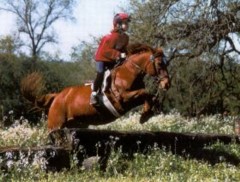The Jump
When the rider prepares to jump, she goes into a "two-point" or jumping position, putting her weight on the balls of her feet. Lift yourself slightly out of the saddle and lean forward. Then keeping her back straight, she lifts herself slightly out of the saddle and leans forward. She will stay in this position while the horse is in the air, going back to her normal riding position when the horse touches the ground. Some riders will hold onto the mane, it won't hurt him.

photo courtesy of Oakridge Stables
|
Some Jumping Tips
- Shorten your stirrups two holes, unless you use long stirrups.
- To keep your horse interested, don't jump the same jump over and over.
- If your horse refuses, make sure you take it again, and put leg pressure on the side that he ducks to.
Here is the right way to learn to jump:
At first an inexperienced rider should use a neck strap so that there is no risk of a nervous or frightened rider pulling hard on the reins and jabbing the horse in the mouth with the bit.
For the approach, sit down in the saddle, keeping close contact with your legs and the horse. Support your weight with your thighs and feet, not with your hands. Never look down, and only use light contact on the reins. You have to allow the horse freedom to move his head and neck.
When the horse leaves the ground, bend your body forward coming slightly out of the saddle. Once in the air, follow the horse's mouth with light contact, bringing your body even farther forward to maintain the center of gravity.
As the horse lands, bring your body back to the normal riding position. And don't fall off!
Dealing with a Horse that Refuses to Jump
What is really going on when a trained horse refuses to jump?
If your horse is refusing to jump, then he or she might be lacking in respect or trust for the rider. Or, even with all the respect and trust in the world, if the rider is not setting up the approach well enough then perhaps the horse is just saying "I can't".
If a horse does not have ample respect and trust for the rider then it just can't realistically be expected to go anywhere and do anything that it doesn't really want to do.
If you know that you and your horse are in a reliable partnership and you think the problem is solely regarding the jumps, then the next question would be is he or she sound enough to be jumping?
But many times, it just comes down to the rider's experience and ability.
|